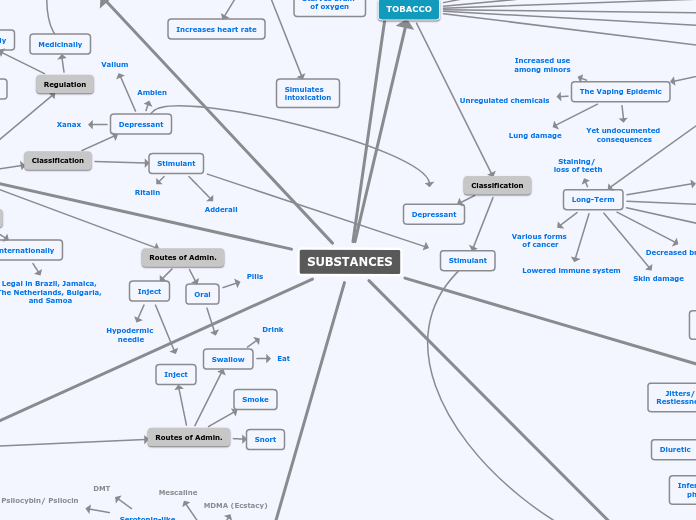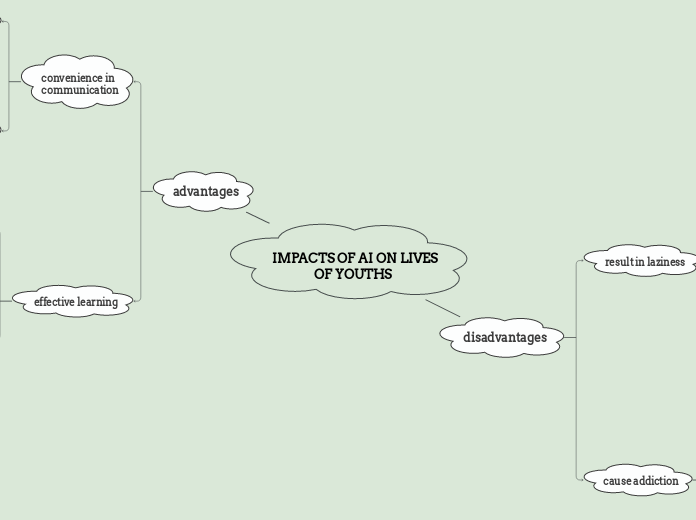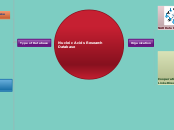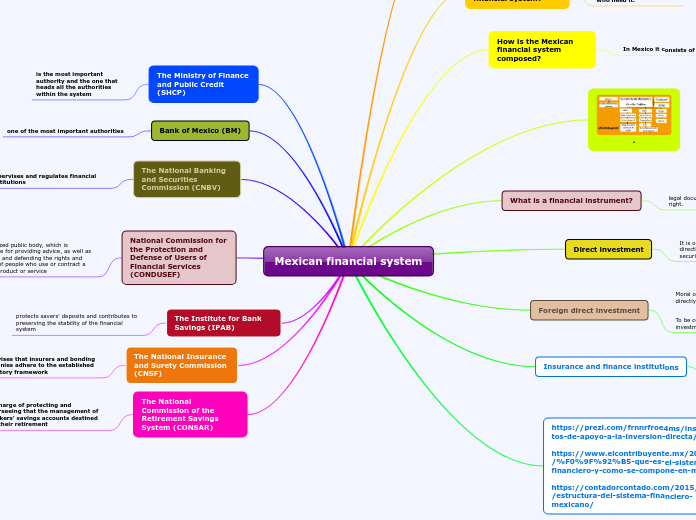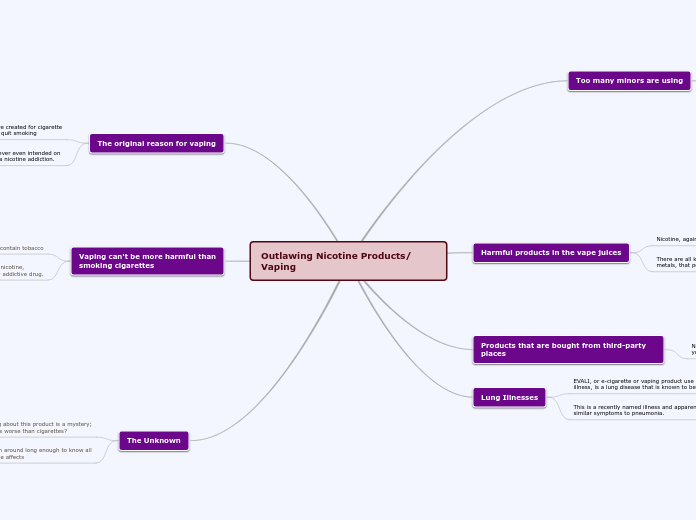SUBSTANCES
PSYCHEDELICS
Tremors
Numbness
Sweatiness
Dryness
of mouth
Weakness
Loss of appetite
Mood instability
Increased
blood pressure
Memory loss
Bi-polar disorder
Psychosis
Take a "trip"
Relaxation
Pupil dilation
Increased body
temperature
Illegal
(Unless...)
Internationally
Legal in Brazil, Jamaica,
The Netherlands, Bulgaria,
and Samoa
Serotonin-like
Psilocybin/ Psilocin
DMT
Catecholamine-like
MDMA (Ecstacy)
Mescaline
Anticholinergic
Schopalamine
Spiritual
practices
Rave-culture
Enhanced sensory experiences
Edible
'Shrooms
Peyote
"Tea"
Powder/
Capsule
PCP
LSD
Synthetics
OPIOIDS
Hypodermic
needle
Oral
Pills
Overdose
Unconsciousness
Constipation
Shortened breath
Drowsiness
Decreased hormone production
Weakened immune system
Central Nervous
System damage
Respiratory damage
Addiction/
dependence
Bradycardia
Heart failure
Hypotension
Gastrointestinal damage
"Normalness"
(i.e. without pain)
Cough supressant
Anti-diuretic
Substance attaches
to nerve cells
to block pain signals
from brain
Adderall
Ambien
Valium
Xanax
Pain management
Synthetic
Fentanyl
Methadone
Semi-Synthetic
Hydromorphone
Oxycodone
Natural
Codeine
Morphine
INHALANTS
Bag
Huff
Sniff
Hearing loss
Muscle
weakness
Heart
failure
Bone-marrow loss
Addictive
Organ damage
Nosebleed
Apathy
Poor judgment
Dizziness
Lack of coordination
Slurred speach
Increase heart rate
Disinhibition
Lightheadedness
Rapid "high"
Starves brain
of oxygen
Simulates
intoxication
Increases heart rate
By a licensed practitioner
Because the doctor said so
Not officially considered
a controlled substance
However,
38 states have
restrict the sales of
inhalable products
to minors
Volatile substances
Toxic fumes
Nitrites
Aerosols
Gases
Solvents
Anesthetic
Get "high"
Spray
Paint
Cooking
Hair
Gas
Laughing
Propane
Butane
Nitrite
Deodorizer
Chemical cleaner
Food
Gasoline
Marker ink
Paint thinner
Glue
METH
Swallow
Inject
Snort
Increased violence/
criminal activity
Hallucinations
Paranoia
Tooth decay
Decreased
mental agility
Brain cell damage
Seizures
Increased exposure
to HIV
Hypothermia
Anxiety
Head "rush" of euphoria
Increased energy
Rapid release
of dopamine in
high quantities
Federally legal
with prescription
Treatment of
narcolepsy
Treatment of ADHD
Ritalin
Desoxyn
Dextromethamphetamine
hydrochloride
Treatment of
obesity
Pill
Powder
Crystal
TOBACCO
Vape
Vape Pen
E-Cigarette
Smokeless
Chewing Tobacco
Snuff Tobacco
Smoke
Pipe
Hookah
Cigar
Cigarette
The Vaping Epidemic
Yet undocumented
consequences
Unregulated chemicals
Increased use
among minors
Lowered
immune system
Reduced sense of smell
Decreased
lung function
Mood swings
Increased heart rate
Shortness of breath
Lowered immune system
Decreased brain function
Various forms
of cancer
Skin damage
Lung damage
Staining/
loss of teeth
Decreased
stress
Increased relaxation
Improved concentration
Improved mood
Surge of adrenaline
Decreased appetite
Illegal until age 21+
in 18 states
Federally legal
at age 18+
Socially
Cured leaves
CAFFEINE
Swallow (Capsules)
Drink
"Caffeine steals from tomorrow
to give energy to today."
Decreased dexterity
Increase anxiety
Crash ("Jolt Effect")
Dehydration
Diarrhea
Unknown effects on
pregnant women/
developing baby
Insomnia
May impact
brain elasticity
Withdrawal symptoms
Nausea
Irritability
Headache
Addiction
Increase
blood pressure
Blocks calcium absorption
Boosts brain function
Increased mental
alertness
Inferred increase in
physical energy
Jitters/
Restlessness
Diuretic
Unless you're
Mormon
Totally legal/
unregulated
Stimulant
Habitually
See "Forms"
Capsules
Butlbital
Acetaminophen
Midol
Energy Drink
Soda
Tea
Coffee
CANNABIS
Apply
Patches
Lotion
Eat
Spreads/
Syrups
Gummies
Baked
Goods
Inhale
Vaporize
Joint/ Blunt
Bong/ Pipe
Damage to internal organ
Failure
Cancers
Diseases
Potential for
addiction
Decline in IQ/
memory/brain
gray matter
Risk of stroke
Short-Term
Sustain a poor odor
Impaired judgment
Red eyes
Increased/
irregular heart-rate
Severe
anxiety
Low reaction time/
poor coordination
Psychological
Effects
CBD
None
THC
Euphoria
Physiological
Effects
Cannabinoids in marijuana
mimic the brain chemical
anandamide to produce
"joy" in the body
State
Recreationally legal
11 states
Medically legal
33 states
Federal
Illegal
Hallucinogenic
Depressant
Relieve stress/
get "high"
Ease the pain of ailments
Cancer
Epilepsy
Alzheimer's
Concentrate
Flower/ Bud
ALCOHOL
Routes of Admin.
Drink it up!
Concerns
Short-term
"Hangover"
Vomiting
Vision blurriness
Alcohol poisoning
Risk of harm
to self/ others due to driving under the influence
Long-Term
Depression
Fetal Alcohol Syndrome
Increased crime/ violence due to drunkenness
Decreased
satisfaction
in life
High
blood-pressure
Psychological Effects
Decreased
inhibition
Increased confidence
Better pick-up lines
Better dance moves
Loss of empathy
Physiological Effects
"Depresses"
Central Nervous System
Slows chemical reactions in brain pathways
Low reaction time
"Rosy"
flush in face
Strain on organs
Pancreas
Liver
Regulation
International
Legal in most other
countries at age 18
Illegal in 12 countries
USA
However, illegal to drink
while driving/ to have a
blood-alcohol content of
0.8% or higher
Presently legal for
persons of age 21+
anyone
Illegal 1920-1933
Classification
(Possibly stimulant?)
Uses
Recreationally
Abuse
Socialize
Grieve
Celebrate
Medicinally
Pre-1900s
(Not current)
Forms
Liquid
Hard Liquor
Beer/ Cider
Wine
